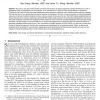139
click to vote
BMCBI
2011
14 years 7 months ago
2011
Background: Phylogenetic trees are an important tool for representing evolutionary relationships among organisms. In a phylogram or chronogram, the ordering of taxa is not conside...
137
click to vote
NAR
2007
15 years 4 days ago
2007
The GeneTrees phylogenomics system pursues comparative genomic analyses from the perspective of gene phylogenies for individual genes. The GeneTrees project has the goal of provid...
119
click to vote
BMCBI
2002
15 years 14 days ago
2002
Background: When analyzing protein sequences using sequence similarity searches, orthologous sequences (that diverged by speciation) are more reliable predictors of a new protein&...
125
Voted
BMCBI
2004
15 years 15 days ago
2004
Background: Common existing phylogenetic tree visualisation tools are not able to display readable trees with more than a few thousand nodes. These existing methodologies are base...
120
Voted
JCB
2007
15 years 16 days ago
2007
Reconstructing phylogenetic trees efficiently and accurately from distance estimates is an ongoing challenge in computational biology from both practical and theoretical consider...
125
Voted
TKDE
2008
15 years 16 days ago
2008
We study a new data mining problem concerning the discovery of frequent agreement subtrees (FASTs) from a set of phylogenetic trees. A phylogenetic tree, or phylogeny, is an unorde...
118
Voted
TALG
2008
15 years 16 days ago
2008
A graph G is the k-leaf power of a tree T if its vertices are leaves of T such that two vertices are adjacent in G if and only if their distance in T is at most k. Then T is a k-le...
141
Voted
NAR
2006
15 years 17 days ago
2006
An entire family of methodologies for predicting protein interactions is based on the observed fact that families of interacting proteins tend to have similar phylogenetic trees d...
104
click to vote
NAR
2008
15 years 17 days ago
2008
TreeFam (http://www.treefam.org) was developed to provide curated phylogenetic trees for all animal gene families, as well as orthologue and paralogue assignments. Release 4.0 of ...
112
Voted
JBI
2006
15 years 18 days ago
2006
Numerous metrics have been developed that attempt to assess the reliability of phylogenetic trees. Several of these commonly used measures of tree and tree branch support are desc...







